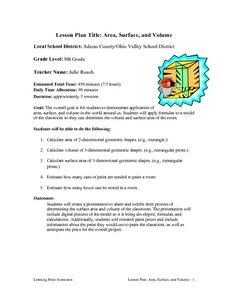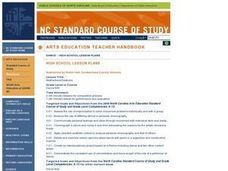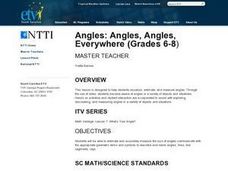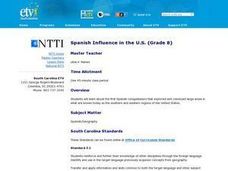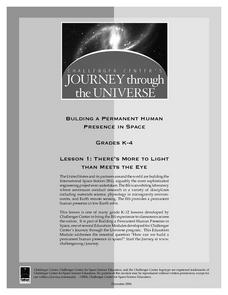Curated OER
Area, Surface, and Volume
Ninth graders demonstrate application of area, surface, and volume. They apply formulas to a model of the classroom so they can determine the volume and surface area of the classroom.
Curated OER
Performance Evaluation
Young scholars evaluate in class performance of music previously prepared by the ensemble. The rubric and assessment criteria are adaptable to any orchestra setting which allows the teacher to choose music to be assessed. Critical...
Curated OER
The Element of Color
Eighth graders study and analyze the elements of color by creating an personalized color wheel. Emphasis is placed on constructive criticism of student work by others for assessment. Students create short poems for their color wheel...
Curated OER
Self-Portrait Unit - Lesson #1
Fourth graders create self-portraits using artistic elements found in Hispanic culture and, specifically, the art of Frida Kahlo. The lesson can be adapted for any culture/country and requires an outside person with cultural knowledge.
Curated OER
Abstractions/Gestures
Students examine and display the differences between literal, and non-literal movement and abstraction using a creative project in movement. This project originates as an individual item, culminating in a small group performance.
Curated OER
Export-Import Game
Students recognize how international trade affects them as consumers and become familiar with basic agricultural crops grown in Kentucky. They identify items used in their daily lives and .heir place of origin and examine export/import...
Curated OER
Kids Conserve? Water Preserved
Sixth graders review the steps of the water cycle. Individually, they calculate the amount of water they use in a day and identify ways they can conserve. As a class, they discuss how conserving water today helps future generations and...
Curated OER
Weather in Your City
Students observe weather conditions of a particular city. Multiple intelligences are explored within this lesson. They locate their particular city on a United States map. Each student writes about their discoveries in his/her journal...
Curated OER
Insects
Third graders research an insect and creates a brochure on that selected insect. Each student develops a Venn Diagram comparing similarities and differences between moths and butterflies.
Curated OER
What is Microbiology?
Students demonstrate knowledge of important advances in microbiology by creating a timeline of microbiological milestones. Student also demonstrate application of the many milestones in microbiology by researching and reporting on the...
Curated OER
- Making Metaphors with Munchies
Students brainstorm independently first, then ask their best friend on the team, or seat partners, depending on the year & student mix, to add to their list of personal characteristics and/or to name three words they think of...
Curated OER
Keith Haring & Social Awareness
Students view four sections of one of Haring's paintings. They describe the people and characters they see. Students participate in a variety of classroom art activities such as: Making a treasure box modeled after Keith Haring's work,...
Curated OER
Ice -T's Rap School
Students research the history of rap and gain an understanding of the components of rap music. They experience the correlation between Shakespeare's poetry and rap music of today.
Curated OER
Storytellers: The Dixie Chicks
Students explore an important moment in the course of American History through critical listening. Students analyze the lyrics of one work by the Dixie Chicks. Students have a better understanding of the way music can mirror social...
Curated OER
Falling Into Geometry Through Paper Art
Students explore geometric shapes. In this kindergarten geometry lesson, students create a fall quilt consisting of three different paper geometric quilt squares that when assembled form a scarecrow, a pumpkin, and a crow. ...
Curated OER
The Ruins of Pompeii: A Window into History
Sixth graders research the history of Pompeii and its destruction. Locate important geographical features of Rome. Gain insight into the past through archaeological interpretation. Synthesize historical information through imaginative...
Curated OER
Donde en el mundo estas?
Learners give & follow directions given in Spanish, using oral, written and graphics. They use maps, globes, atlases, and remote sensing, GIS, and GPS to acquire and process information about places.
Curated OER
The Hunter Using Children's Literature to Teach the Geography of Africa
Students are able to answer basic questions about the region and the use of natural resources, sketch a mental map of the story's setting, and find their way through the thematic maze/map.
Curated OER
Let's Go To Mexico
Students are able to use the Internet to conduct research. They research Mexican culture and traditions. Students compare and contrast Mexican and U.S. food and clothing. They convert United States currency to Mexican pesos. Students...
Curated OER
Angles: Angles, Angles, Everywhere
Students practice estiminating and measuring angles. After watching a short video, they identify angles in objects in the classroom and their homes. In groups, they participate in activities in which they are given a scenerio and are...
Curated OER
Spanish Influence in the U.S.
Eighth graders research the role of the first Spanish conquistadors who explored the now United States. Using the internet, they gather information on different explorers and write a paper about why he is important in American history. ...
Curated OER
The Greenhouse Experiment
Students create a town with all the elements to sustain human life. They discuss how the activities of the people in the town may create greenhouse gases. They make a connection between small unrelated activities and their cumulative...
Curated OER
Ethics of Exploration
Students examine space exploration and its domination by governments as well as the fact that some private businesses want to explore space too. They investigate the ethical questions surrounding a space exploration through research and...
Curated OER
There's More to Light than Meets the Eye
Learners explore the concept that not all light is visible to the
human eye. Although UV light is not visible, it can still be harmful, causing sunburns or skin cancer. They use special beads to detect UV light around the school....
Other popular searches
- Self Discipline
- School Discipline
- Classroom Discipline
- Positive Discipline
- Self Discipline
- Child Discipline
- Discipline and Parents
- Elementary School Discipline
- Discipline Plans
- Discipline Academics
- Discipline Strategies
- The Lords of Discipline
